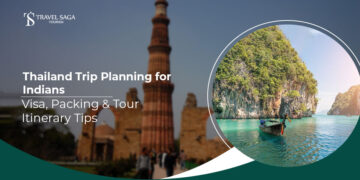Introduction to the Kerala Backwater Tour
The Kerala backwater tour offers a calm and immersive travel experience for those looking to disconnect from busy city life. These backwaters are a web of serene lakes, canals, rivers, and lagoons running parallel to the Arabian Sea coast. This region, especially famous in places like Alleppey and Kumarakom, allows visitors to enjoy lush greenery, traditional houseboats, and the quiet rhythms of village life.
What sets this tour apart is not just the scenery but also the lifestyle that thrives on water. Locals depend on the backwaters for everything—transportation, fishing, agriculture, and even cultural traditions. From sunrise to sunset, every moment spent gliding along these waters presents a closer view of Kerala’s natural and cultural richness.
Why the Kerala Backwater Tour is Different from Typical Travel Routes
Unlike mountain trails or beach holidays, the Kerala backwater tour is about moving slowly. The pace of life here mirrors the gentle flow of water. There are no fast lanes or crowded monuments—just calm stretches of green, floating homes, and time to reflect. This form of travel prioritizes quiet experiences over packed itineraries.
Houseboats, or kettuvallams, are one of the unique features of this journey. These boats were once used to carry rice and spices but now serve as floating hotels. They come with all the modern comforts—air-conditioned rooms, kitchens, and even open decks—making it a smooth yet grounded travel experience. A ride on one of these boats means watching coconut palms pass by, hearing birdsong instead of car horns, and truly unwinding.
Top Destinations on the Kerala Backwater Tour
1. Alleppey: The Houseboat Capital
Known as the heart of the Kerala backwater tour, Alleppey offers a wide range of houseboat experiences. From short day trips to overnight stays, there are many options to suit different preferences. As you sail, you’ll see paddy fields submerged in water, children rowing canoes to school, and fishermen throwing nets at dawn.
2. Kumarakom: Birdlife and Tranquility
Located near Vembanad Lake, Kumarakom is a quieter, more natural part of the backwaters. It’s especially popular with those interested in birdwatching. The Kumarakom Bird Sanctuary hosts local and migratory birds, making it a peaceful retreat for wildlife lovers. Here, your backwater ride may include glimpses of herons, kingfishers, and maybe even a rare Siberian crane.
3. Kollam: Less Crowded, More Local
South of Alleppey, Kollam is less commercial but equally beautiful. It offers a more authentic feel of the Kerala backwater tour, with local life in full view. You’ll pass coir-making villages, toddy shops, and small temples, all set against a lush green backdrop. For those who prefer lesser-known spots, Kollam is worth adding to the itinerary.
Life on a Houseboat During the Kerala Backwater Tour
Living on a houseboat for a day or more is a special part of this tour. These boats are made using traditional methods—wooden planks tied with coir ropes and covered with bamboo and palm leaves. But inside, they’re fitted with beds, bathrooms, dining areas, and even Wi-Fi in some cases.
Meals are cooked onboard, typically using fresh, local ingredients. Expect rice, vegetables, coconut-based curries, and freshly caught fish. Sitting down to eat while drifting along quiet waters is a memory that stays long after the tour ends.
The crew usually includes a captain and a cook, both of whom know the region well. Many visitors enjoy chatting with them to learn about the local customs and stories tied to each stretch of the backwater.
Best Time to Plan a Kerala Backwater Tour
Timing plays an important role in making the most of the Kerala backwater tour. The ideal period is between October and March when the weather is cooler and drier. During this time, the skies are clear, and the water is calm, making it perfect for houseboat rides.
Monsoon months (June to September) bring heavy rain, which, while beautiful in its own way, can limit movement and visibility. However, this season does draw visitors looking for quiet off-season travel and lush surroundings.
Cultural Experiences Along the Backwaters
The backwater region is not just about nature—it’s also rich in traditions and community life. As you drift along, you may come across local festivals, temple ceremonies, and folk performances. Villages often host small events that travelers can attend by request.
Some houseboat operators also arrange visits to coir-making units, paddy fields, or even local schools. These experiences offer insights into the lives of people who have lived in harmony with water for generations. Their routines, values, and ways of work reflect a different kind of wisdom—one rooted in simplicity and sustainability.
Eco-Tourism and Responsible Travel
Sustainability is becoming increasingly important in how people travel. Fortunately, many Kerala backwater tour operators are moving toward eco-friendly practices. This includes waste management on houseboats, using solar power, and offering reusable items instead of disposables.
Travelers can also make conscious choices—such as booking with certified operators, avoiding plastic, and respecting local customs. Supporting local guides and craftspeople not only enriches the tour but also helps sustain the community.
What to Pack and Prepare
A smooth Kerala backwater tour begins with a little preparation. Here’s what you’ll likely need:
- Light cotton clothing (it gets humid)
- Comfortable sandals or slippers
- Sunglasses and a hat for sun protection
- Mosquito repellent, especially for evenings
- A camera or phone for capturing views
- Basic medicines (though most boats carry first aid kits)
While many houseboats come with facilities, it’s a good idea to carry your essentials. Also, remember that network connectivity may drop in certain stretches. It’s the perfect excuse to unplug.
Duration and Cost Considerations
The Kerala backwater tour can last from a few hours to several days. A half-day cruise is enough to get a feel for the water, but an overnight stay lets you fully relax and enjoy the rhythm of rural life.
Prices vary depending on the type of houseboat, the amenities offered, and the season. Simple boats are budget-friendly, while premium ones offer luxury services including private chefs, full air-conditioning, and even spa treatments onboard. Booking through local operators often results in better deals and more authentic experiences.
Local Food and Flavors to Expect
Kerala cuisine is a key part of the backwater tour. Meals on houseboats usually follow traditional cooking methods, with a focus on fresh, local ingredients. Must-try dishes include:
- Karimeen pollichathu (pearl spot fish wrapped in banana leaf)
- Avial (a vegetable mix with coconut and curry leaves)
- Prawns roast cooked with black pepper and spices
- Appam and stew – a light rice pancake with coconut-based curry
These meals are typically served on banana leaves and accompanied by chutneys or pickles. Drinking water is filtered and available onboard, but carrying a reusable bottle is a good habit.
How to Reach the Backwaters
The major entry points to the Kerala backwater tour—like Alleppey, Kumarakom, and Kollam—are well connected by road and rail. The nearest airport is Cochin International Airport, around 80 km from Alleppey.
From there, private cabs, buses, or trains can take you to your chosen destination. Some travelers also book packages that include pick-up, boat stay, and meals, which simplifies planning.
Final Thoughts
The Kerala backwater tour is not just a trip—it’s a pause from fast-paced routines. It invites travelers to slow down, pay attention, and reconnect with both nature and local traditions. Whether you choose a short ride or a week-long journey, the experience stays with you. From the reflections on water to the warmth of local hospitality, every part of this tour offers a kind of calm that’s rare in today’s travel world.
For anyone seeking natural beauty, quiet time, and cultural depth, this tour is one of the most meaningful ways to see Kerala.















